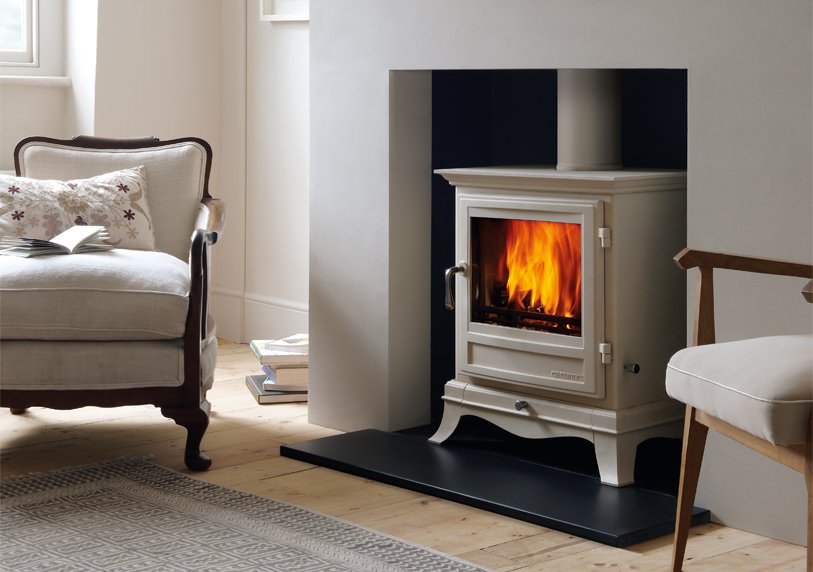

How To Use And Maintain Your Multi-Fuel Stove: A dream home isn’t complete without a fireplace, but if storing enough wood is a problem, a multi-fuel stove may be perfect. Load your multi-fuel stove with logs, coal, or manufactured fuels like briquettes, and multi-fuel stoves will give you plenty of options to warm your home: all without sacrificing a fire’s classic elegance.
You’ll find a multi-fuel stove is worth every penny, but getting the most out of it requires knowledge of how it works and how to maintain it. This guide will ensure you avoid common mistakes and help you keep your stove in prime condition, to enjoy its warmth and energy efficiency for years to come.
Your multi-fuel stove will have several components, including:
Firebox: This is the main compartment of the stove, into which fuel is loaded and lit.
Door: Allows access to the firebox to load fuel and light the fire, with a glass window providing a clear view of the flickering flames.
Air vents: These let you moderate the stove’s air supply, controlling how quickly your fuel burns.
Flue: The pipe connected to the roof of the stove, allowing smoke to escape up through your chimney. Find out more about flue installation, and whether a multi-fuel or wood burning stove is best for you.
All Chesneys stoves are built with the latest clean-burn and airwash technology. These reduce emissions by re-igniting the harmful particulates initially burned from fuel. So long as the fuel used in the stoves is properly seasoned for burning, the clean-burn technology ensures pollutants are burned away, so Chesneys stoves contribute to a cleaner environment.
Modern multi-fuel stoves are built to be as fuel efficient as possible. Chesneys’ stoves like the Beaumont and Belgravia boast A+ efficiency, heating your home with an 83.9% net efficiency (for comparison, most stoves average at around 70% efficiency).

THE BEST WAY TO USE A MULTI-FUEL STOVE
Lighting a multi-fuel stove is easy and safe, as long as you follow the right method. Open the door to your stove and place a firelighter on top of a bed of fuel, such as logs or coal. Cover this stack with kindling, then place more logs, coal, or briquettes around it. The firelighters should be lit directly, and once the fire begins burning consistently, add more fuel as required to keep it lit.
Leave the air vents on your stove open immediately after the fire has been lit to provide plenty of air flow into the firebox. This helps the fuel to catch. When your fire has reached the desired level, close the primary air vent to halfway. This will prevent burning through fuel too quickly and maintain a steady temperature.
Reviving a dying fire is simply a case of adding more kindling followed by fuel, and reopening the air vents to give the fire an extra dose of oxygen. A fire can be tamed if it becomes too hot, or put out completely, by closing the primary air vent completely.
MAINTENANCE FOR MULTI-FUEL STOVES
Multi-fuel stoves require some basic maintenance to keep them in good condition, prevent damage and maximise their efficiency.
Removing excessive ash from your stove will prevent it from piling up, which may cause problems. Ash should never be touching the underside of your stove’s grate, so empty your ash pan regularly to avoid this. Be sure to fix your ash pan in place securely after cleaning it so that it continues to catch ash next time you light your stove.
To maintain a beautifully clear view through the glass in your stove door, it’s important to clean it regularly – allowing soot and creosote to linger here could cause discolouration. Wire wool or damp newspaper dipped in ash can be used to clean the glass window. Alternatively, choose a product that’s specially designed to use on stoves. Carefully remove any dampness and residue, and wait until your stove has completely dried before using it again.
Always hire a professional to sweep your chimney rather than attempting to do it yourself. Having this done at least once a year will keep your stove safe, efficient and environmentally friendly.
THE BEST FUEL FOR MULTI-FUEL STOVES
Multi-fuel gives you more fuel options than any other stove. There’s no single ‘best’ fuel, although you should be careful to avoid burning unsuitable materials as these could be damaging and dangerous. Never burn household rubbish, wood that’s been treated or painted, cardboard, or any other item that isn’t recommended in your appliance guidelines.
If you’re burning wood in your stove, make sure that it has been properly seasoned (dried out) first. The moisture content of your logs should be 20% or lower to stop excessive smoke and pollution, not to mention wasted energy.

If coal is your fuel of choice, avoid household coal and opt instead for a smokeless fuel. This is kinder to the environment, cleaner, more cost-effective, and less damaging to your stove. Burning smokeless coal and wood together can be an effective way to limit lingering moisture from logs that might affect your fire.
Browse our full collection of multi-fuel stoves online, or find your nearest stockist right here. For more stove advice, visit our blog or follow us on Facebook, Twitter, Instagram or Pinterest
Need help?
If you need more information or some assistance making a selection from our large range of products, don’t hesitate to get in touch.
Stoves
Chesneys have a range of accessories that include contemporary and traditional fire tools, fire screens and a selection of interior panels
